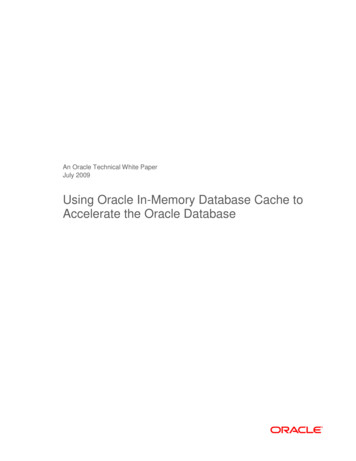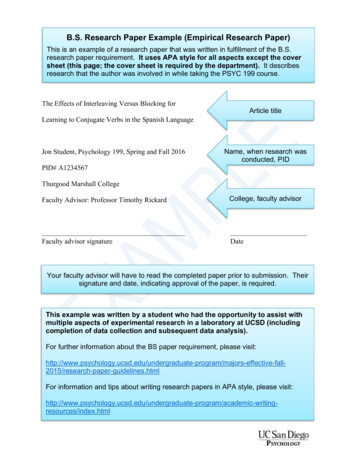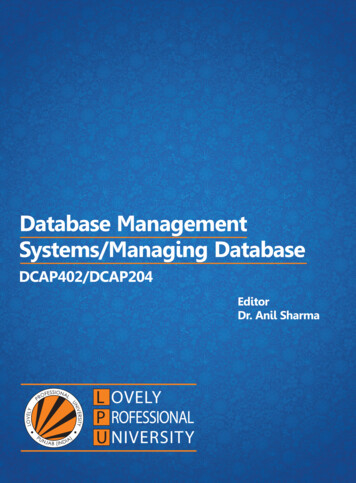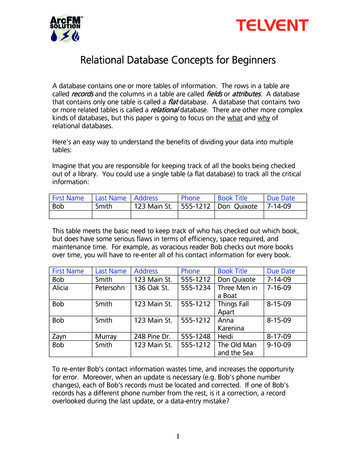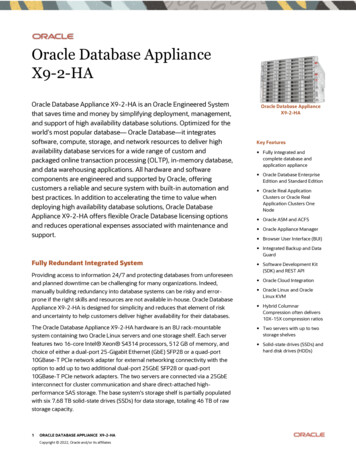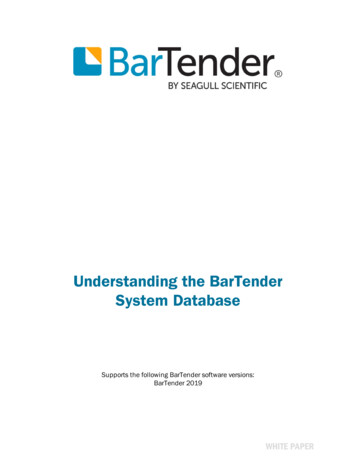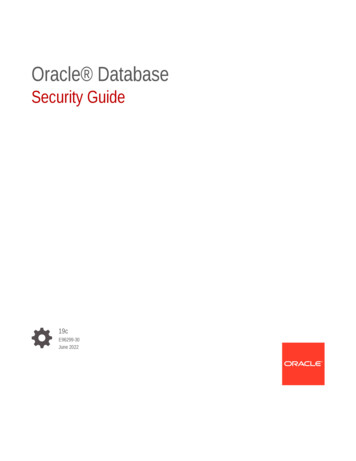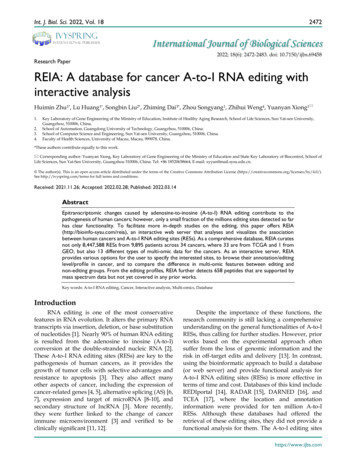
Transcription
Int. J. Biol. Sci. 2022, Vol. 18IvyspringInternational Publisher2472International Journal of Biological Sciences2022; 18(6): 2472-2483. doi: 10.7150/ijbs.69458Research PaperREIA: A database for cancer A-to-I RNA editing withinteractive analysisHuimin Zhu1*, Lu Huang1*, Songbin Liu2*, Zhiming Dai3*, Zhou Songyang1, Zhihui Weng4, Yuanyan Xiong1 1.2.3.4.Key Laboratory of Gene Engineering of the Ministry of Education, Institute of Healthy Aging Research, School of Life Sciences, Sun Yat-sen University,Guangzhou, 510006, China.School of Automation, Guangdong University of Technology, Guangzhou, 510006, China.School of Computer Science and Engineering, Sun Yat-sen University, Guangzhou, 510006, China.Faculty of Health Sciences, University of Macau, Macau, 999078, China.*These authors contribute equally to this work. Corresponding author: Yuanyan Xiong, Key Laboratory of Gene Engineering of the Ministry of Education and State Key Laboratory of Biocontrol, School ofLife Sciences, Sun Yat-Sen University, Guangzhou 510006, China. Tel: 86 18520658664; E-mail: xyyan@mail.sysu.edu.cn. The author(s). This is an open access article distributed under the terms of the Creative Commons Attribution License (https://creativecommons.org/licenses/by/4.0/).See http://ivyspring.com/terms for full terms and conditions.Received: 2021.11.26; Accepted: 2022.02.28; Published: 2022.03.14AbstractEpitranscriptomic changes caused by adenosine-to-inosine (A-to-I) RNA editing contribute to thepathogenesis of human cancers; however, only a small fraction of the millions editing sites detected so farhas clear functionality. To facilitate more in-depth studies on the editing, this paper offers REIA(http://bioinfo-sysu.com/reia), an interactive web server that analyses and visualizes the associationbetween human cancers and A-to-I RNA editing sites (RESs). As a comprehensive database, REIA curatesnot only 8,447,588 RESs from 9,895 patients across 34 cancers, where 33 are from TCGA and 1 fromGEO, but also 13 different types of multi-omic data for the cancers. As an interactive server, REIAprovides various options for the user to specify the interested sites, to browse their annotation/editinglevel/profile in cancer, and to compare the difference in multi-omic features between editing andnon-editing groups. From the editing profiles, REIA further detects 658 peptides that are supported bymass spectrum data but not yet covered in any prior works.Key words: A-to-I RNA editing, Cancer, Interactive analysis, Multi-omics, DatabaseIntroductionRNA editing is one of the most conservativefeatures in RNA evolution. It alters the primary RNAtranscripts via insertion, deletion, or base substitutionof nucleotides [1]. Nearly 90% of human RNA editingis resulted from the adenosine to inosine (A-to-I)conversion at the double-stranded nucleic RNA [2].These A-to-I RNA editing sites (RESs) are key to thepathogenesis of human cancers, as it provides thegrowth of tumor cells with selective advantages andresistance to apoptosis [3]. They also affect manyother aspects of cancer, including the expression ofcancer-related genes [4, 5], alternative splicing (AS) [6,7], expression and target of microRNA [8-10], andsecondary structure of lncRNA [3]. More recently,they were further linked to the change of cancerimmune microenvironment [3] and verified to beclinically significant [11, 12].Despite the importance of these functions, theresearch community is still lacking a comprehensiveunderstanding on the general functionalities of A-to-IRESs, thus calling for further studies. However, priorworks based on the experimental approach oftensuffer from the loss of genomic information and therisk in off-target edits and delivery [13]. In contrast,using the bioinformatic approach to build a database(or web server) and provide functional analysis forA-to-I RNA editing sites (RESs) is more effective interms of time and cost. Databases of this kind includeREDIportal [14], RADAR [15], DARNED [16], andTCEA [17], where the location and annotationinformation were provided for ten million A-to-IRESs. Although these databases had offered theretrieval of these editing sites, they did not provide afunctional analysis for them. The A-to-I editing siteshttps://www.ijbs.com
Int. J. Biol. Sci. 2022, Vol. 18were long known to be closely connected withfeatures of many omics: the A-to-I editing sites have acomplementary relationship with the DNA mutationof hepatocellular carcinoma (HCC) risk genes in HCCpatients [18]; those sites in the 3’UTR region can alsoaffect the miRNA expression in a variety of cancers[19, 20]; and they can even be used as the indicator tobuild a cancer prognostic model [12]. Furthermore,the A-to-I RNA editing contributes to the proteindiversity of cancer. Such functional non-synonymousediting can affect the structure, the function, and drugtargets of the protein, and therefore, it is of greatinterest to the precise treatment of cancer [21]. Forthese reasons, the association analysis between A-to-IRESs and multi-omic features is essential to thecommunity.In this paper, we provide a new web server forsuch analysis. The server is termed REIA, a databasefor A-to-I RNA editing in cancers with interactiveanalysis, which is publicly available at http://bioinfosysu.com/reia. The architecture of REIA is shown inFigure 1. Different from existing databases thatpresented only the information stored [14, 17], this2473new server allows for an iterative analysis, i.e.,conditions, such as editing positions and cancer types,can be customized arbitrarily, and their influence onthe indices of multi-omic features will be calculatedand visualized accordingly. By doing this, the papercontributes these two aspects: (1) In terms of data set,REIA has detected 8,447,588 A-to-I RESs from theRNA-Seq data of 9,895 tumor patients across 34cancers, where 33 are from TCGA whilenasopharyngeal carcinoma (NPC) is from GEO. NPCis a rare tumor of the head and neck, which originatesin the nasopharynx. It is more common in southeastAsia and is frequently, but not always, caused by theEpstein-Barr virus (EBV). The detection is carried outusing a combination of TCEA [17] and REDIportal[14] to embrace both regular and hyper editing sites.REIA also collects 13 types of multi-omic data relatedto human cancers from four different levels, namely,DNA level (including somatic mutation, gene copynumber, DNA methylation, telomere length,microsatellite instability, tumor purity and ploidy),transcriptome level (including gene expression,miRNA expression, alternative splicing), protein levelFigure 1. Overall description of the web server REIA. Overall description of the web server REIA. REIA has identified 8,447,588 A-to-I RESs from 9,895 patients across34 cancers (TCGA GEO), on which 13 different types of multi-omic data are also collected. The editing sites can be retrieved by RES positions, host gene names, cancer types,or any of their combinations. An association analysis between these editing sites and the multi-omic data is provided, which covers 14 aspects of 4 different levels, including DNA,transcript, protein and clinical. Result of the analysis can be downloaded in PDF/PNG/SVG format.https://www.ijbs.com
Int. J. Biol. Sci. 2022, Vol. 18(protein expression), and clinicopathology level(immune cell infiltration, stem indices, and patientsurvival). In addition to the above collections, REIAfurther identifies 658 novel peptides fromnon-synonymous peptides that are supported bymass spectrum (MS) data. These novel peptides, to thebest of the authors’ knowledge, have not been coveredin any prior reports. As they are cancer-specific, thepeptides may affect the occurrence and developmentof cancers. (2) In terms of analysis, REIA isadvantageous to many prior works not only because itis interactive but also because it is multi-functional.On one hand, similar to our previous work, a keyenabler for the interactive analysis is the model-viewcontroller (MVC) framework [22]. Unlike priordatabases that were mostly using bootstrap [14, 23],REIA here applies MVC to handle user interface,business logic, and data management in a divide-andconquer fashion, which makes the interaction andmaintenance much easier. On the other hand, REIAnot only provides a retrieval for the editing sites, butalso analyzes and visualizes their association with 13multi-omics features in 33 different cancers. Inaddition, it offers for the 658 peptides identifieddetailed information, such as RES coordinates,sequence, gene name, mutant and wild-type bases onamino acids, codons, and distribution in cancers,paving the way for targeted therapies. The overallarchitecture of the database is shown in Figure 1.Summing up, the web server REIA offers a newRNA editing database operating on the per cancerbasis and opens up a new avenue for the research inassociation of A-to-I RNA editing with cancermulti-omics features.Materials and MethodsDetection for A-to-I RNA editing sites1) Data Collection: The overall process is shown inFigure 1. We download the data of 15,679,823 A-to-Iediting sites from REDIportal 2.0 [14] ml) andmerged it with the 8,972,972 sites from TCEA [17](hg38, http://tcea.tmu.edu.tw). After removing theduplicates, we obtained a candidate set of 15,680,513sites, which covers most (if not all) editing sites everdetected in human samples, either normal orcancerous. Together we have 9,895 samples, in which9,697 RNA-seq bam files (V21.0) across 33 cancertypes included in TCGA are downloaded fromGenomic Data Commons (GDC, https://gdc.cancer.gov), while the remaining 198 files are fromGEO (GEO, https://www.ncbi.nlm.nih.gov/geo) onnasopharyngeal carcinoma (NPC). For somaticmutation, we download the data from GDC and for2474Germline single nucleotide poly-morphisms (SNPs)from GDC and dbSNP (V151, https://www.ncbi.nlm.nih.gov/snp).2) RES Detection: The 15,680,513 sites collectedabove serves as a candidate set of our RES Known.py) under the same setting asPicardi et al. [24, 25] to detect the A-to-I RESs. Forunmapped reads, we apply SPRINT [26] (http://sprint.tianlan.cn), a SNP-free toolkit; however, unlikemost previous studies which considered only hyperRESs [14, 17], we detect both hyper and regular RESsfrom unmapped reads, but leave only those in thecandidate set. To further improve the detectionquality, we add some filtering similar to [27]:supported reads 10, edited sample number per cancertype 2, editing level (defined as edited G reads / A Greads) 0.1%, and loci annotated only in a single strand.Also, to reduce the false positive rate, we excludeediting sites overlapped with germline SNPs andsomatic mutations relevant to DNA variants. Finally,we have detected 110,264,281 regular editing eventsand 92,751,089 hyper events, from which acomprehensive collection of 8,447,588 A-to-I RESs areidentified.3) RES Annotation: To annotate the RESs, cs.org/en/latest) together withGencode (v34), Refseq and UCSC for gene structure,dbSNP (v151), ExAC, GnomAD (v30) for variant,COSMIC (v92) and ClinVar for disease, RepeatMaskfor repetitive elements, PhyloP and PhastCons fromUCSC (https://genome.ucsc.edu) for conservationscore across 100 vertebrates. Annotated sites are thendivided either into 8 types by their locations in thegenomic region, or into 3 types by the repeat region.The 8 genomic- region types include exonic, intronic,intergenic, UTR3, UTR5, ncRNA intronic, ncRNAexonic, and splicing, while the 3 repeat-region typesare ALU, REP, and NONREP.Curation of TCGA multi-omic dataWe provide 13 types of multi-omic data to relatethe detected editing events with molecular features of33 cancers in TCGA and its follow-up studies. FromPanCanAtlas [29], we download somatic mutation(2,979,333 mutations), CNV (24,205 genes), 450K betavalue of DNA methylation (396,066 CpG sites), tumorpurity and ploidy, TPM-normalized gene expression(20,531 genes), miRNA expression (2,455 miRNA),and clinical outcome indices across 33 cancers ofTCGA. From [30], we obtain the expressioninformation about 198 proteins of 7,746 TCGApatients. From TIMER2.0 [31], we collect the data ofimmune cell component, which includes thehttps://www.ijbs.com
Int. J. Biol. Sci. 2022, Vol. 182475infiltration level of 26 immune cells in 11,010 TCGAtumor samples. From [32], we obtain the data aboutsix tumor stemness indices (DMPsi, ENHsi, mDNAsi,EREG-mDNAsi, mRNAsi, and EREG-mRNAsi) forthe measurement of oncogenic dedifferentiation.From [33], we collect the PSI values of five AS types(exon skipping, alternative 3’ splice site, alternative 5’splice site, mutually exclusive exons, and intronretention) in 8,705 patients. From [34] and [35], weobtain, respectively, the telomere length andmicrosatellite instability information. This multi-omicdata is summarized as Table 1.Identification for novel peptidesTable 1. Summary of multi-omic dataFeaturesSomatic mutationCopy number variation (CNV)DNA methylationTelomere lengthPurity and ploidyMicrosatellite instability (MSI)Gene expression (TPM)miRNA expressionAlternative splicingProtein expressionImmune cell infiltrationStem indicesPatient 551982662essential to the development of cancers, with somebeing prognostic markers [36]. We thus collect 22pathways commonly shared by cancers. From [36], weobtain 10 canonical signaling pathways across 9,125samples in 33 cancers, including cell cycle, Hippo,Notch, and P53. Other pathways collected includefeeroptosis [37], hypoxia [38], and m6A methylation[39]. The gene sets of these 22 pathways aredownloaded from MSigDB (https://www.gseamsigdb.org/gsea/msigdb). Throughout the paper,we use patient ID as our unique index for all dataused in the interactive ,2509,4058,7057,74611,0109,39911,160Particularly for gene expression, previousstudies had demonstrated gene pathways areWe also apply a sample-customized searchstrategy, as shown in Figure 2A, to identify novelpeptides that are derived from the detected editingsites.1) Construct a set of variation-associated peptides:First, we generate a variant call format (VCF) fileaccording to the RNA editing sites obtained by usingSAMtools and R scripts. Then, we download anmRNA sequence file (GRCh38) and a gene annotationfile from UCSC (http://genome.ucsc.edu/cgi-bin/hgTables?command start). Also, we download theexternal cross reference file, xref, from ew/).Finally, we use the R package of sapFinder [40]Figure 2. Data flow and software architecture of the web server REIA. (A) Detailed pipeline for novel peptide detection. (B) Software architecture of the web server.https://www.ijbs.com
Int. J. Biol. Sci. 2022, Vol. /30/21/3136/2422150) to construct a data set forpeptides associated with then RNA editing. A list ofall potential peptides resulting from RNA editingevents is then obtained and labeled as “peptide setA”.2) Select peptides supported by cancer mass spectrum:In this step, the peptides are validated via massspectrum (MS) data. We download the mzML formatdata about 9 cancers from Clinical Proteomic TumorAnalysis Consortium (CPTAC) [41], and extract onlythe MS2 spectra from each dataset. We then merge thedata into a single file in mgf-format using the tool ofmsconvert from ProteoWizard. After that, we pick outthose peptides supported by the MS data via the useof the X!Tandem algorithm [40]. That algorithm wasparticularly useful to the handling of variantidentification in high false positive cases. Similar tothe prior work of [27], we set the parent ion masstolerance and fragment ion mass tolerance(monoiso-topic mass) in this study at 10 ppm and 0.1Da, respectively. Moreover, the protein cleavage siteis fixed at ‘‘[KR]j[X]’’ to allow for 2 missed cleavages,while the PSM FDR in sapFinder is set to be 0.01.Under the above settings, we have identified 15,035MS-supported peptides, which are denoted as“peptide set B”.3) Identify novel peptides: Finally, we identifypeptides listed in the above “set B” but not yetcovered in any of the following databases: Uniprot[42], RefSeq [43], GENCODE V30 [44], and Ensembl96 (https://asia.ensembl.org/index.html). To thisend, we apply the Basic Local Alignment Search Toolof Protein Database (BLASTP) to search for peptidesthat contain at least one unmatching with the peptidesof the above databases. We obtain a list of 658 suchunmatched peptides and label them as “novelpeptides”.Implementations of web serverWe develop REIA, a new web server for theRNA A-to-I editing interactive analysis, using theMVC framework. MVC is a state-of-the-art designpattern that implements data, user interface, andcontrolling logic of a software in a divide-andconquer fashion. Three components are included inMVC: the Model for managing data and businesslogic, the View for handling layout and display, andthe Controller for routing commands to the formertwo. In Figure 2B, we illustrate the operation flow ofour MVC-based web server REIA. Here the View(graphical user interface, GUI) contains a VUEprogressive javascript framework and an Element-UIframework. Once a request is received, it forwardsthat request to the Controller via ajax. The Controller,2476implemented in a JAVA SpringBoot framework,routes the request the Model which later appliesbusiness logic to address the request. In the Model, aDAO-based MyBatis persistence layer framework isused to read data from the MySQL database. This datais then returned to the Controller and gets furtherprocessed by R and Python scripts. For figures andtables generated, the Controller decides which Viewto call and via what display method (supportedmethods: PDF, PNG, and CSV). It is worthy of noting,in order to reduce the storage burden of the webserver, we do not put all data in its online MySQLdatabase. Instead, we leave some data less frequentlyused to another server in back office. When functionslike AS and Methylation are called, such data will besent directly from the back-office server to theController of the (online) server.Results and DiscussionOverviewThe web site of REIA has 6 tabs, namely, Home,Analysis, Statistics, About, Help, and Download,where 1) Home: overview of the server, search anddisplay of interested RESs; 2) Analysis: associationbetween RESs and multi-omic molecular features,identification of novel peptides; 3) Statistics: statisticalinformation of the database; 4) About: introduction tothe server; 5) Help: usage and examples; 6)Download: data of the database, see Figure 3.To better demonstrate the usage of “Home” and“Analysis”, we take COPA I164V (chr1 160332454) asour example throughout this section. We use COPAI164V simply due to its great generality in cancers andits tight connection with other omics features, e.g.,patient survival, protein diversity, and geneexpression [21, 45]. Thus, we pinpoint, in the “Home”page, COPA I164V as our target position and move onto the “Analysis” page to divide the patients into twogroups (edited or not) and further carry out theirinteractive analysis with 13 multi-omic features. Moredetails will be elaborated immediately in the twosubsections that follow.Search and display of editing sitesREIA has collected 8,447,588 editing sites from 34cancer types for search and display. Among the 34cancers, STAD, NPC, and ESCA have the highestnumber of editing sites, while LGG, OV, and BRCAare the second highest (Figure 3, the box plot of“Statistics” page). This difference is partially due tothe variation in sample size and/or sequencing depth.Among the 8,447,588 sites, most of the editing sites arelocated in 3’UTR and intronic (Figure 3, the bar plot of“Statistics” page), which resembles the prior works of[14, 17, 26].https://www.ijbs.com
Int. J. Biol. Sci. 2022, Vol. 182477Figure 3. User interface of the web server REIA. The navigation page contains 6 tabs: Home, Analysis, Statistics, About, Help, and Download. The “Home” tab retrievesthe editing sites and displays their annotation information and editing levels. The “Statistics” tab summarizes the data collected in REIA. The “Download” tab provides links todownload the collected data. The “Analysis” tab analyzes the association between RESs and multi-omic features, and this will be introduced later in next figure using an exampleof the COPA I164V editing site.For search, REIA offers 3 inquiry modes in the“Home” page: i) “RESs Browser” for inquiry via RESs,including chromosome and editing site coordinate; ii)“Gene Browser” for inquiry via genes, including genename, gene region, repeat type, and amino acidschange; and, iii) “Cancer Browser” for inquiry viacancers, including cancer type and number of editedsamples. Across the three, all items could becombined arbitrarily. To display the search result,REIA provides a table for the annotation and thedistribution of each editing site, which containscoordinates, strand, genomic position, referencenucleotide, edited nucleotide, region of cytoband,gene name, gene region, repeated element (if any),potential amino acid change, disease-specific sites,PhyloP and PhastCons conservation score across 100vertebrates, databases (ATLAS/RADAR/DARNED/TCEA/REDIportal) reporting the RES, and number ofedited samples per cancer type. Following each itemof the table is a button of “Plot”, which plots thedistribution of editing level (defined as the number ofedited G reads over the number of A G reads) at theselected position in each cancer type. Yet anotherbutton is “Add”, which adds the current position intothe input list of a multi-omic analysis to be detailed innext tab “Analysis”. For the aforementioned exampleof COPA I164V, we use the setup illustrated in Figure3.Interactive analysis with multi-omic dataIn the “Analysis” tab, REIA provides, for 33TCGA cancers, 13 types of interactive analysis at 4different levels, including DNA, transcriptome,protein, and clinicopathology. The site position(s) ofinterest can be either imported from the search result(in last tab) or customized at will. Also, all interactiveanalysis supports the selection of any cancer(s) withinthe 33. For each selection, the samples are divided intotwo groups, an “editing” group and a “non-editing”,according to their status at the site position(s). In theanalysis that follows, sample ID is used as the uniqueindex for all data. In the same tab, REIA furtherprovides 658 cancer-specific peptides that are derivedfrom A-to-I RNA editing and supported by massspectrum, but not reported in the existing databases.For each of the analysis functions, the selected index isthen plotted for comparison between the two groups.Wilcoxon rank-sum test is adopted in all significanceanalysis throughout this paper. The p-values here aretwo-tailed, and Benjamini and Hochberg (BH) FDR isused as a correction for multiple comparisons.For better illustration of REIA, we take theediting site of COPA I164V (chr1 160332454) in breastcancer (BRCA) as our running example. Previousstudy has shown that the edited COPA I164V not onlyenhances cell viability, wounding healing, migrationand invasion significantly, but also make a notablecontribution to the tumor development [21].https://www.ijbs.com
Int. J. Biol. Sci. 2022, Vol. 18DNA level interactive analysisAs RNA editing affects a variety of molecularfeatures, REIA here investigates 6 major ones on thegenome level, i.e., mutation, CNV, telomere length,DNA methylation, MSI, tumor purity and ploidy.For somatic mutation, REIA provides 2,017,901mutation sites. On one hand, somatic mutation isclosely related to RNA editing at certain sites [18]; onthe other hand, RNA editing techniques can repair thesomatic mutation of human [13, 46] and even correctthe carcinogenic mutation for cancer prevention [13,47]. Despite that, our knowledge of the underlyingassociation between RNA editing and somaticmutation is still fragmental. Now with REIA, one isable to see the difference in such mutation betweenthe editing and non-editing groups. REIA offers twoperspectives of somatic mutation analysis, namely,exclusive mutations and enriched mutations. Forexclusive mutations, REIA provides a table for thesomatic mutations of the editing group and a table forthe non-editing group. For enriched mutations, REIAcalculates the enrichment p-value for each mutation inthe editing group identified by Fisher’s exact test.Such analysis allows the users to connect the editingevents with mutation profiles and generate varioushypotheses on the connections. For example, usingREIA, one can identify 18,771 mutations from BRCApatients that have the editing at COPA I164V(chr1 160332454). For each somatic mutation, one canfurther check information like its overlapped gene,genome coordinate position, and the variantclassification (Figure 4A).For CNV, REIA offers the information of 24,205variations. CNVs is known to influence the cancer’sglobal abundance of protein and phosphosite [48, 49];however, its connection with RNA A-to-I editing isstill not clear. Here, REIA provides an opportunity toexplore such potential connections in a quantitativeway. To be specific, one can pin point the interestedediting site(s), gene name(s), and/or cancer type(s),and obtain a violin plot that quantify the CNVdifference between the editing and the non-editinggroups. In the example of COPA I164V, the editinggroup exhibits a level of copy number amplificationsignificantly higher than the non-editing group(p 0.0015, Figure 4B).For telomere length, REIA compares thedistributions of the editing and the non-editinggroups. Stability of telomere tandem repeats(TTAGGG)n hexameric DNA repeats of telomeres) iscritical to cancer progression, as it ensures both thestability of chromosomes and the integrity of genome:the shorter a telomere, the higher its risk in cancer[50]. In this context, REIA offers a comparison inboxplot-based telomere length between the editing2478and the non-editing groups. Such comparisonfacilitates the studies on possible associations betweenRNA editing and telomere length.For DNA methylation, REIA calculates the βvalues therein. As the prior work demonstrated [51],DNA methylation directly affects microRNAbiogenesis in mammalian cells, thus resembling theRNA editing in many aspects. However, itsassociation with RNA editing is yet to be verified. Forthis reason, REIA provides volcano plot-based DNAmethylation comparison between the patients withand without RNA editing. The comparison can serveas a starting point for the association analysis betweenRNA editing and DNA methylation.For microsatellite instability (MSI), REIA plotsthe distribution of its event number. MSI, as a majorcarcinogenetic pathway [52], has a distributionrecognized as the implication for many cancers [53].For that reason, REIA implements the comparison ofMSI indices between the editing and the non-editinggroups, which may help to identify clinical targets. Inthe COPA I164V example, the MSI in the editinggroup is seen to be significantly higher than thenon-editing group (p 0.00018, Figure 4C).For tumor purity and ploidy, REIA computes thetwo values to investigate their (possible) associationwith the A-to-I editing. Tumor purity and ploidy havea great impact on cancer genomic evolution andtumor heterogeneity, thus affecting severely cancerprogression and patient survival [54, 55]. Accordingto the boxplot, a significantly higher level of ploidyother than purity could be observed in the patientwith chr1 160332454 editing in BRCA (p 0.029 andp 2e-16, Figure 4D).Transcript level interactive analysisRNA editing in cancers may affect many featureson the transcript level [56]. In REIA, we analyze 3 ofthese aspects, namely, gene expression, alternativesplicing, and microRNA expression.REIA provides 20,531 gene expressions and thegene sets of 22 classic pathways related to cancers.A-to-I RNA editing was known to have an overallinfluence on the gene expression of most cancers [36].Here REIA offers an approach to precisely measurethe difference between the editing and non-editinggroups on the expression of a single gene or gene set.With the boxplot REIA generated, the users canexplore the underlying influence of editing events ona single gene. With the volcano plot generated, userscan determine the differentially expressed genes inany gene sets. In the COPA I164V example, theexpression level of IGF-1 (insulin-like growth factors)in the P53 signaling pathway of the editing group canbe seen to be significantly higher than that of thehttps://www.ijbs.com
Int. J. Biol. Sci. 2022, Vol. 18non-editing group (Figure 4E, the cutoffs for log2FCand p-value are 1 and 0.01, respectively). Note that the2479over-expression of this gene had long been known incancers like GBM and HCC.Figure 4. Analysis result of editing and non-editing groups in the example of COPA I164V in BRCA. (A) Somatic mutation results indicated some mutations thatappear specifically in patients with COPA I164V event in BRCA. (B) Violin plots showing the CNV levels of COPA between COPA I164V editing and non-editing group across BRCA.https://www.ijbs.com
Int. J. Biol. Sci. 2022, Vol. 182480(C) Boxplot of microsatellite instability between editing and non-editing group patients in BRCA. (D) Barplots of Tumor purity and ploidy in the patient group with and withoutCOPA I164V event in BRCA. (E) Volcano plot indicated that the expression levels of IGF-1 in the P53 signaling pathway of the editing group patients were significantly higher thanthose in the non-editing group. (F) Landscape of differentially expressed miRNA between BRCA editing and non-editing group patients. (G) Landscape of differentially expressedproteins between COPA I164V editing and non-editing group in BRCA. (H) Novel peptides resulted from COPA I164V. (I) Survival analysis comparing the over
3. School of Computer Science and Engineering, Sun Yat-sen University, Guangzhou, 510006, China. 4. Faculty of Health Sciences, University of Macau, Macau, 999078, China. *These authors contribute equally to this work.


